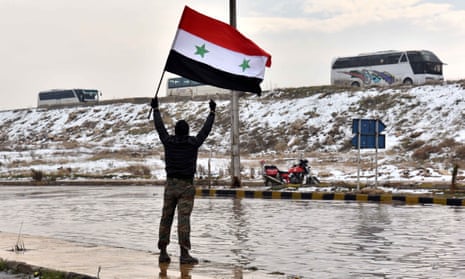The evacuation of east Aleppo has been completed, bringing to a close a key chapter in the Syrian rebellion against the country’s president, Bashar al-Assad.
About 4,000 rebel fighters and civilians left the city on Thursday, the last group remaining in the shrunken patch of territory still nominally held by the opposition in the city.
The Syrian army said it had retaken Aleppo entirely and brought “security and safety” back to the city.
The last evacuations bring the total number of people who have left east Aleppo in the last week to a little over 40,000. Their departure came about under a deal brokered by Turkey and Russia that teetered on the edge of collapse several times.
Tens of thousands of civilians had been facing the prospect of death in a final stand against Assad’s offensive, spearheaded by Iranian-backed militias, or of surrendering and facing imprisonment or forced “disappearances”. The militias have been accused of killing people as they rampaged through east Aleppo.
The residents had lived in great deprivation without functioning hospitals and with little electricity and water in freezing winter conditions.
After meeting a senior Iranian delegation, Assad said his battlefield successes were a “basic step on the road to ending terrorism in the whole of Syria and creating the right circumstances for a solution to end the war”.
But a senior United Nations official warned that the thousands of evacuees could endure the same situation in their new place of refuge outside the city. Many have gone to the province of Idlib, which is under the control of Islamist rebels and is expected to be the next target of Assad’s campaign.
The UN special envoy for Syria, Staffan de Mistura, said an end to hostilities across Syria was vital if another battle like that for Aleppo was to be avoided.
“Many of them have gone to Idlib, which could be in theory the next Aleppo,” De Mistura said in Geneva.
The Assad regime now controls the whole of Aleppo more than four years after it was divided in a rebel offensive.
The loss of the former industrial capital is a major blow to the rebellion, which no longer has a strong presence in any of Syria’s major cities, relegating it to a rural insurgency dominated by the Islamist rebels still standing in Idlib.
Much of the eastern and northern parts of the country remain outside government control, and recent defeats in places such as Palmyra raise questions about the ability of Assad’s exhausted military and its militia allies to hold on to territory outside key cities.
But buoyed by its momentum, largely the result of unflinching support from its allies in Moscow and Tehran, the Assad regime will aim to push forward and capitalise on the opposition’s disarray.
The Aleppo campaign was marked with great brutality, particularly in the last few months when pro-government forces placed the eastern rebel-held districts under siege and pursued a relentless policy of aerial bombardment that deployed weapons such as bunker-buster bombs and phosphorus.
Prior to the evacuations, the last ceasefire broke down in October over the bombing of a humanitarian convoy, an act believed to have been carried out by the Russian or Syrian government.
On Thursday, the British foreign secretary, Boris Johnson, claimed the UN panel of inquiry into that attack had concluded it was carried out either by the Syrian or Russian air force, describing the incident as indefensible and one of the most appalling of the conflict.
The inquiry, often hampered by the Syrian government, found that the attack was conducted from the air, and said there had been no suggestion the attack was conducted by coalition aircraft, implying it was done by the Russians or Syrians.
The five-strong panel, which visited Syria, said it had no conclusive evidence as to whether the attack was an error or that those responsible knew the target was a joint UN-Syrian Arab Red Crescent convoy. Ten people died in the incident and 22 people were injured.
At various points Russia or Syria had claimed the attack was conducted by ground forces, thus leaving open the possibility that rebel forces were responsible. But the inquiry found the attack was mounted from the air using multiple types of munitions deployed from more than one aircraft and aircraft type.
Johnson said: “I welcome the board of inquiry’s report, which found that the aid convoy was attacked from the air, making it clear that the strike was carried out by forces of either the Assad regime or Russia.
“This was one of the most appalling incidents of the conflict so far. Whether deliberate or accidental, this was an indefensible attack, with at least 10 people killed and vital aid to vulnerable people destroyed.
“Over half a million Syrians are still in areas besieged by the regime – many have received no aid since June.”
